|
|
|
Sort Order |
|
|
|
Items / Page
|
|
|
|
|
|
|
| Srl | Item |
| 1 |
ID:
132779


|
|
|
|
|
| Publication |
2014.
|
| Summary/Abstract |
Simultaneous rapid rise in both the world oil and agricultural commodity prices have increased interest in determining price transmission from oil prices to those of agricultural commodities. However, although a lot of the empirical research has studied the relation between oil price changes and economic activity, it is surprising that little research has been conducted on the relationship between oil price shocks and the large-size emerging industrial countries agricultural market. Therefore, the main goal of this study is that we are try to use the more detail and new China's weekly data which from 2004/9 to 2012/9 to fill this gap. This study examines the short and long-run interdependence between China fuel oil prices and the average of different kinds of key agricultural commodity prices in China. To this end, the Toda-Yamamoto causality approach and impulse response analysis method are applied to identification of the long and short-run interrelationships. In contrast to lots of the traditional causality analysis indicates that the oil prices and the agricultural commodity prices do not influence each other, our result is mix: we have inferred that the fluctuation of fuel oil price has a short-run effect on the dynamics of agricultural products in China; however, there are no significant in the long-run effects.
|
|
|
|
|
|
|
|
|
|
|
|
|
|
|
|
| 2 |
ID:
138043
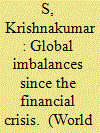

|
|
|
|
|
| Summary/Abstract |
This paper undertakes an appraisal of the origins of global imbalances since the late 1990s, examines the link to the global financial crisis and the consequences of the untavelling of the existing financial system on emergin market economies.
|
|
|
|
|
|
|
|
|
|
|
|
|
|
|
|
| 3 |
ID:
129682
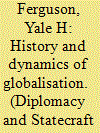

|
|
|
|
|
| Publication |
2014.
|
| Summary/Abstract |
Globalisation involves geographically wider transaction networks and has multiple interrelated dimensions. The globalisation process has geographical scope, volume and density of transactions, and a direction and pace of change. Globalization has a long history, and the local and the global have almost continuously interacted. Most forward changes have been incremental, and there have also been major reversals or almost complete system-breakdowns. There are numerous drivers of globalization of different types, persons, and groups with varying motives, and anonymous drivers like technology, weather, and disease. The article devotes most attention to a review of selected patterns and trends in contemporary globalisation These are climate change; demographic trends, income inequality, and migration; security concerns, technology, and peacekeeping; competing ideologies; the global economy, equities, trade, banking reform, and tax havens; and shifting power relationships among the United States, Europe, China, Japan, and Emerging Markets.
|
|
|
|
|
|
|
|
|
|
|
|
|
|
|
|
| 4 |
ID:
183129


|
|
|
|
|
| Summary/Abstract |
This research identifies how windows of opportunity (WOP) emerge and influence the catching up process of the Chinese electric vehicle (EV) industry between 1995 and 2018 by analyzing technological, institutional, and market demand elements of the WOP. Our case study indicates that government policies play a vital role. Along with the development of Chinese EV industry, government policies evolve from initiation to consolidation and finally reposition. Meanwhile, WOP emerge but diverge in their patterns; from institutional to technological and finally to the market demand WOP. Our study further elaborates the interplay of the above-mentioned three kinds of WOP, which provide feedback to the government authorities and work jointly to facilitate the catching up of Chinese EV industry. Based on the evidence of the Chinese EV industry, we continue the discussion of the emergence and interplays of WOP during the industrial catching up in latecomer countries like China, who is eager to build an energy-saving industry. Our case study provides a fine-grained analysis of policy evolution and its role in opening the different kinds of WOP, which eventually contribute to the successful catching up of a latecomer industry. It also offers new insights for policymakers when building a sustainable system.
|
|
|
|
|
|
|
|
|
|
|
|
|
|
|
|
| 5 |
ID:
133648
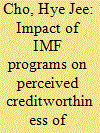

|
|
|
|
|
| Publication |
2014.
|
| Summary/Abstract |
This article examines whether the impact of International Monetary Fund (IMF) programs on the perceived creditworthiness of a country is conditional on government partisanship. Left-of-center governments tend to suffer from greater credibility problems in financial markets than right-wing governments, because they are typically believed to pursue expansionary policies and have less respect for debt obligations. Applying the conventional wisdom held as "Only Nixon can go to China," I argue that adopting IMF programs can benefit leftist governments more than other types of governments. The logic of the Nixon paradox implies that market-oriented reforms have greater credibility when implemented by a left-of-center party, whose ideologies do not accord well with the IMF's neoliberal policies, than when implemented by a right-wing party. This is because market participants interpret the action by a leftist government as driven more by a willingness to commit to market-oriented reform than by ideological affinity. Using sovereign credit rating data for almost 90 emerging market countries from 1980 to 2004, I find robust evidence consistent with the "Nixon-Goes-to-China" hypothesis. The findings suggest that adopting IMF programs improves the perceived creditworthiness of leftist governments, whereas no such benefit is found among non-leftist governments.
|
|
|
|
|
|
|
|
|
|
|
|
|
|
|
|
| 6 |
ID:
132569
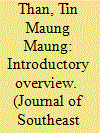

|
|
|
|
|
| Publication |
2014.
|
| Summary/Abstract |
President Thein Sein's government launched a series of political, economic and administrative reforms soon after assuming power in March 2011. The economic reform agenda emphasizes good governance, transparency and accountability while including measures for attracting foreign direct investment (FDI), liberalizing trade, enhancing regional economic cooperation, reducing the state's economic role, boosting productivity and balancing equity with efficiency. A more systematic exposition of reforms is the government's Framework for Economic and Social Reforms (FESR). With the removal of most of the Western punitive sanctions, liberalization of finance, banking, trade and investment sectors and replacement of the overvalued fixed exchange rate with a managed float, Myanmar, with its rich natural resources and virtually untapped market, has become the favoured emerging market for the international business community. However, the country's economic transition is not going to be smooth as there are many structural and other problems inherited from decades of mismanagement and neglect, as well as socio-political challenges. Meanwhile, little research on problems and issues in the various economic sectors is available to the reformist government, whose lack of capacity makes it all the more difficult to institute reforms. However, the returning international financial institutions, Western government-linked aid agencies and private consultancies have brought in expertise to narrow the information gap. In this special edition on Myanmar reforms, issues related to external trade, exchange rate, finance, banking, business environment and potential economic strategies, which are vital components of the reform agenda and crucial for Myanmar's sustained growth, are analysed.
|
|
|
|
|
|
|
|
|
|
|
|
|
|
|
|
| 7 |
ID:
108354
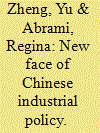

|
|
|
|
|
| Publication |
2011.
|
| Summary/Abstract |
Why have China's petrochemical and steel industries behaved so differently in seeking trade protection through antidumping measures, especially given that both industries face the full force of the global economy? We argue that the patterning of antidumping actions is best explained in terms of industrial structures, inclusive of degrees of horizontal concentration and vertical integration. These structures determine a firm's motivation to seek protection as well as its capacity to overcome collective action problems within its industry. In the petro-chemical industry, the shift toward greater horizontal consolidation and vertical integration reduces the collective action problems associated with antidumping petitions among upstream companies. It also weakens downstream companies lobbying in favor of the general protection of highly integrated conglomerates. In the steel industry, by contrast, national industrial policy fails to weaken local state interests sufficiently. Fragmented upstream and downstream channels instead persist, with strong odds against upstream suppliers waging a successful defense of material interests. Such distinctive industrial structures, we show, were a direct result of whether the central government could restructure these designated priority industries in its preferred direction. We find that exogenous price shocks proved particularly helpful in this regard.
|
|
|
|
|
|
|
|
|
|
|
|
|
|
|
|
| 8 |
ID:
186489


|
|
|
|
|
| Summary/Abstract |
Renewable energy is a key component for increasing resilience and limiting climate change, along with ecological benefits and energy independence for developed and less developed countries alike. Surprisingly, the expansion of wind and solar energy capacity varies tremendously between countries, even considering the different economic and natural conditions. While some countries have changed their energy mix to a substantial extent, others have not yet unlocked their potential for renewable energies. Our paper thus asks for diverse factors explaining varying patterns of renewable energy potential exploitation from 2010 to 2019. Besides structural conditions and general political factors, we focus on specific regulatory, market, and funding policy instruments packages. We find that while regulatory and market instruments, as well as electoral democracy and government effectiveness matter for the expansion of wind and solar electricity production, high oil rents seem to counteract it. While regulatory instruments played a crucial role in the ‘implantation phase’ at the beginning of the 2010s, its impact declined over time while market instruments' effect increased over the ‘sprouting phase’ years of 2010s. This points to an increased market-readiness of the technology following years of market penetration
|
|
|
|
|
|
|
|
|
|
|
|
|
|
|
|
|
|
|
|
|